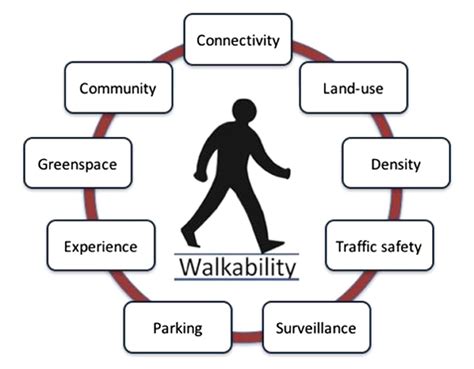Introduction
Walkability, a crucial concept in urban planning and human geography, refers to the ease and attractiveness of walking in a particular area. It encompasses various factors that influence the pedestrian experience and determine the desirability of walking as a mode of transportation. Understanding walkability is essential for creating livable and sustainable communities.

Components of Walkability
Walkability is measured through a combination of objective and subjective indicators, including:
- Physical Infrastructure: Sidewalks, crosswalks, traffic signals, street lighting, and other physical elements that facilitate walking.
- Safety: Low crime rates, well-lit streets, and safe intersections enhance pedestrian comfort and reduce the perceived risk of walking.
- Connectivity: A well-connected street network with short distances between destinations encourages walking.
- Accessibility: Wide sidewalks, curb ramps, and accessible crossings accommodate people with disabilities and the elderly.
- Attractiveness: Green spaces, public art, and street amenities make walking enjoyable and aesthetically pleasing.
Benefits of Walkability
Walkability offers numerous benefits for individuals and communities:
- Improved Health: Regular walking promotes physical activity, reduces sedentary behavior, and lowers the risk of chronic diseases such as heart disease, diabetes, and obesity.
- Reduced Traffic Congestion: By providing a viable alternative to driving, walkability reduces traffic volume, improving air quality and reducing greenhouse gas emissions.
- Boosted Social Interaction: Walkable streets promote social interaction and encourage community building by providing opportunities for chance encounters and conversations.
- Increased Economic Activity: Pedestrian-friendly areas stimulate local businesses, attract new residents, and increase property values.
- Enhanced Sustainability: Walkability promotes environmental sustainability by reducing energy consumption and reliance on motorized transportation.
Measuring Walkability
Several tools are available to measure walkability, including:
- Walk Score: A widely used measure that assigns a score based on factors such as street connectivity, sidewalk coverage, and proximity to destinations.
- Pedestrian Environment Index (PEI): A comprehensive assessment tool that evaluates the physical environment, safety, and aesthetic appeal of pedestrian areas.
- Observational Surveys: Researchers conduct surveys to observe pedestrian activity, traffic patterns, and the overall pedestrian experience.
Walkability in Urban Planning
Incorporating walkability into urban planning is crucial for creating livable and sustainable communities. Strategies include:
- Compact Development: Designing neighborhoods with short distances between destinations, reducing the need for driving.
- Complete Streets: Planning roads that prioritize all users, including pedestrians, cyclists, and public transit.
- Green Infrastructure: Integrating parks, greenways, and other open spaces into urban fabric, providing attractive and accessible walking paths.
- Pedestrian-Friendly Streets: Implementing traffic calming measures, such as stop signs and speed bumps, to create safer and more inviting walking environments.
Case Studies of Walkable Cities
Numerous cities worldwide have successfully implemented walkability initiatives, including:
| City | Walkability Score | Features |
|---|---|---|
| Copenhagen, Denmark | 94 | Compact city design, extensive bike lanes, pedestrian-friendly streets |
| Portland, Oregon, USA | 78 | Dense, mixed-use neighborhoods, excellent public transit, bike-sharing program |
| Vancouver, Canada | 87 | Green infrastructure network, pedestrian-only streets, dedicated bike lanes |
| Amsterdam, Netherlands | 90 | Canals, bike paths, and a compact city center that encourages walking |
Walkability: A Future Focus
As concerns about climate change, public health, and urban livability intensify, walkability is likely to become an increasingly important consideration in urban planning and development. By creating pedestrian-friendly environments, cities can promote healthy living, reduce congestion, enhance community life, and contribute to a more sustainable future.
Coining a New Word: “Ambuirability”
To further emphasize the importance of walkability for all, let’s coin a new word: “ambuirability.” Ambuirability describes the ease and safety of walking for people with different abilities, including those with disabilities, the elderly, and children. By incorporating ambuirability into our urban planning vocabulary, we can ensure that our communities are accessible and welcoming to everyone.
Tables
Table 1: Walkability Metrics
| Metric | Description |
|---|---|
| Walk Score | A numerical score that measures the walkability of a given location |
| Pedestrian Environment Index (PEI) | A comprehensive assessment of the physical environment, safety, and aesthetic appeal of pedestrian areas |
| Pedestrian Count | The number of pedestrians observed in a given area during a specific period |
| Time Spent Walking | The average amount of time spent walking in a given area |
Table 2: Benefits of Walkability
| Benefit | Impact |
|---|---|
| Improved Health | Reduces risk of chronic diseases, promotes physical activity |
| Reduced Traffic Congestion | Decreases traffic volume, improves air quality |
| Boosted Social Interaction | Promotes community building, encourages chance encounters |
| Increased Economic Activity | Stimulates local businesses, increases property values |
| Enhanced Sustainability | Reduces energy consumption, promotes environmental sustainability |
Table 3: Strategies for Enhancing Walkability
| Strategy | Description |
|---|---|
| Compact Development | Designing neighborhoods with short distances between destinations |
| Complete Streets | Planning roads that prioritize all users, including pedestrians |
| Green Infrastructure | Integrating parks, greenways, and other open spaces into urban fabric |
| Pedestrian-Friendly Streets | Implementing traffic calming measures and creating safe walking environments |
Table 4: Walkable Cities
| City | Walkability Score | Features |
|---|---|---|
| Copenhagen, Denmark | 94 | Compact city design, extensive bike lanes, pedestrian-friendly streets |
| Portland, Oregon, USA | 78 | Dense, mixed-use neighborhoods, excellent public transit, bike-sharing program |
| Vancouver, Canada | 87 | Green infrastructure network, pedestrian-only streets, dedicated bike lanes |
| Amsterdam, Netherlands | 90 | Canals, bike paths, and a compact city center that encourages walking |
